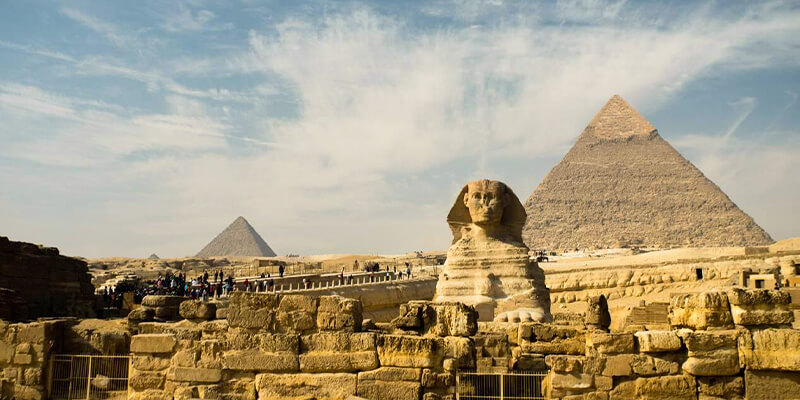The Mysteries of Ancient Egypt have long captivated the minds of historians, archaeologists, and enthusiasts alike. You can’t say enough about how important it is to study these mysterious parts of Egyptian culture. As we learn more about the Pharaohs and their lost world, we learn much about one of history’s most advanced and long-lasting societies.
First, learning about Ancient Egypt’s secrets can teach you much about their structured society and complicated beliefs. The Giza pyramids, the detailed art of hieroglyphics, and the fact that mummification practices have been kept alive all point to an educated society that knew much about science, building, and religion. Scholars can piece together the ancient Egyptians’ social structure, religious views, and daily routines by looking at these riddles. This gives us more information about a time long gone.
Furthermore, exploring the mysteries of Ancient Egypt allows us to gain a deeper understanding of the human quest for immortality. The elaborate ways people were buried, like mummifying them and burying them with valuable things, show that they had a strong belief in the future. By looking at these rituals, we can see that the ancient Egyptians thought keeping the body alive was the only way to live forever. This focus on life tells us a lot about the human mind, our desire to go beyond ourselves, and how important it is to keep our identities.
Studying the mysteries of Ancient Egypt also connects us to our modern-day society. The ancient Egyptians were the first to do many things, like medicine, farming, and building. Their progress in these areas changed their society and led to many scientific ideas and methods we use today. By figuring out the secrets behind their techniques and new ideas, we can enjoy the fantastic things our ancestors did and see the similarities between their work and what we do today.
In conclusion, the importance of studying the mysteries of Ancient Egypt lies in unlocking the secrets of an extraordinary civilization that left an indelible mark on human history. Ancient Egyptians knew much about science, faith, and life after death. This was clear from their grand buildings and complicated beliefs. By figuring out these secrets, we learn a lot about their society, improve our understanding of what it’s like to be human, and make a more vital link to our past.
Unraveling the Enigmatic Mysteries of Ancient Egypt
The Pyramids of Giza: Architectural Wonders or Extraterrestrial Signposts?
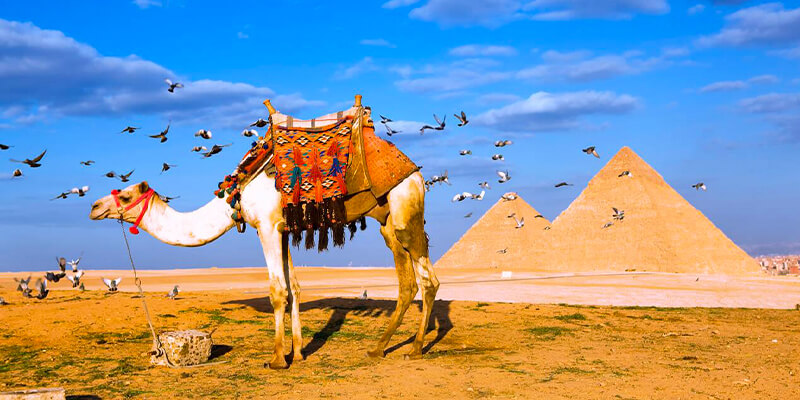
- The Great Pyramids of Giza have stood for thousands of years as proof of how good the ancient Egyptians were at building things. These vast buildings have not only confused historians and scientists but have also led to many ideas about how they were built and what they were used for. Most current experts believe that the Egyptians were the ones who made them, but there is a constant fringe theory that says aliens made them.
- Since they were built about 4,500 years ago, the Great Pyramids of Giza have amazed people with their unique designs. Experts are still puzzled by the complicated ways these vast buildings were built. The fact that the ancient Egyptians could build the pyramids with such accuracy shows how good they were at making things. The neatly cut stones, the way they line up with the stars, and the size of these structures show that they were carefully planned and built.
- But in addition to these well-documented building methods, there are some exciting ideas about how the pyramids were built. One of the most interesting ideas is that these massive buildings were constructed with the help of people from other planets. People who believe this idea say that older adults couldn’t have built the pyramids with as much accuracy and complexity as they did. They think these buildings were signs left by advanced aliens who came to Earth long ago.
- Even though the alien idea is exciting and adds to the mystery of the pyramids, there isn’t enough proof to support it. The science world thinks that the pyramids were only built by people using their creativity. The Egyptians were very good at building and engineering, as shown by their other beautiful facilities and objects. Also, there is a lot of proof that the pyramids were made by people, such as the finding of old mines and building tools that have survived.
- Like many other old secrets, the Great Pyramids of Giza continue to make people wonder and make up stories about them. Even though most people think that humans have done amazing things, the idea of working with aliens is still fascinating. Whether you think of them as architectural marvels or signs from another planet, these grand buildings are a memory of the beauty and secrets of Ancient Egypt. Exploring the mystery and complexity of the pyramids reminds us of the fantastic skills of our ancestors and feeds our never-ending interest in the unknown.
Tutankhamun’s Curse: Fact or Fiction?
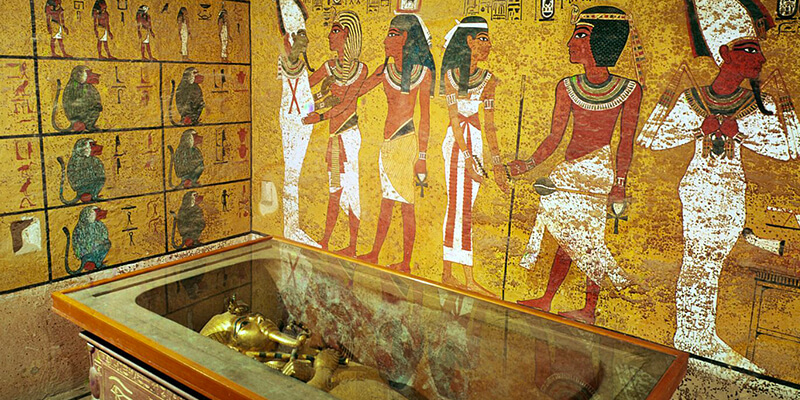
- The Mysteries of Ancient Egypt never fail to captivate and intrigue us. One of these mysteries is the “Curse of the Pharaohs,” which became famous when King Tutankhamun’s tomb was found. The boy, King Tutankhamun, who ruled Egypt briefly in the 14th century BC, was buried with wealth and jewels that are hard to imagine. But the rumored curse around his tomb was what everyone talked about.
- The “Curse of the Pharaohs” is the belief that anyone who breaks the endless rest of an ancient Egyptian king will have bad luck, get sick, or die. This idea first got people’s attention when several people who helped open and dig up Tutankhamun’s tomb died suddenly and unexpectedly. Newspapers spread the story, making it more well-known and giving it an air of mystery and fear.
- But did the curse happen? Or did the media make up the story? Experts say there is no solid proof that the curse exists. They say that the people who were said to have died because of the curse died for natural reasons or by pure chance. But the curse still has a lot of appeal and continues to capture millions worldwide’s imaginations.
- Even though there is no proof, many people still wonder if something magical happened when Tutankhamun’s body was found. Some ideas say that the curse could have been deadly mold or germs that made people sick or even killed them. The airtight environment of the tomb, which had not been touched for hundreds of years, could have let out dangerous germs.
- On the other hand, skepticism says that the curse was just a lie made up by the media. They think the deaths were just a coincidence or were caused by existing health problems. Most people who worked on the dig lived long after the tomb was found, which goes against the idea that the curse was strong.
- No matter what side you’re on, you can’t deny that “The Curse of the Pharaohs” interested people worldwide in Ancient Egypt and its secrets. The finding of Tutankhamun’s tomb is still one of the most important historical finds, and the tales and stories about it continue to make people curious and want to learn more.
- Ultimately, it’s still unclear what the “Curse of the Pharaohs” is and what it has to do with Tutankhamun’s tomb. Even though skeptics say it’s a myth, its continued success shows how much we’re still interested in the mysterious world of Ancient Egypt. As we learn more about the secrets of Tutankhamun’s tomb, we also learn more about how people want to know about the mysterious and the unknown.
The Secrets of the Rosetta Stone: Decipher the secrets held
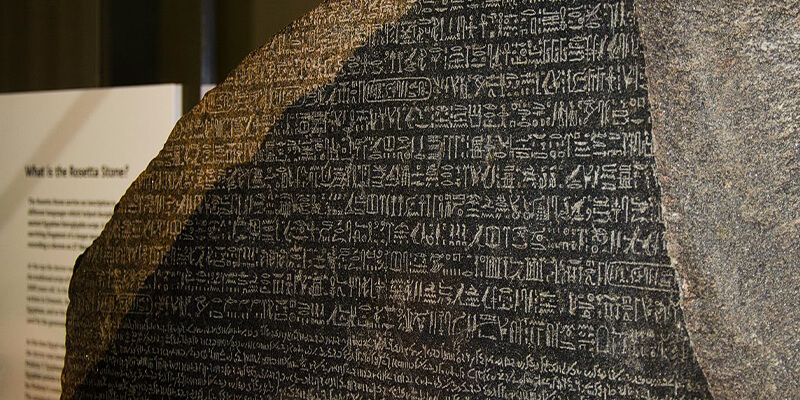
- Egypt’s old culture has always fascinated scholars and archaeologists because of its long past and unique way of writing, called hieroglyphics. The Rosetta Stone is one of the most well-known things that has helped people understand this strange language. Since it was found in 1799 during Napoleon’s war in Egypt, this stone has become a symbol of the search for answers about ancient Egypt.
- The Rosetta Stone, a black basalt slab with writing in hieroglyphic, demotic, and Greek, turned out to be the key that opened the door to understanding Egyptian hieroglyphs. Before it was found, this old writing system would be hard to figure out. But the British genius Thomas Young and the French scholar Jean-Francois Champollion made great strides in deciphering the hieroglyphs with the help of the Rosetta Stone.
- One of the most complex parts of reading old Egyptian hieroglyphs was figuring out how the patterns related to the sounds or meanings they stood for. The Rosetta Stone was a significant step forward in this area. Young and Champollion found repeated words and symbols by matching the Greek text, which was already known and understood, with Egyptian and demotic writing. They figured out the complicated Egyptian code through careful research and hard work.
- The Rosetta Stone is important not only because it can decipher the hieroglyphs but also because of its place in history. The writings on the stone tell the story of King Ptolemy V and include an order from Egyptian priests that praises the young king and ensures that his rule will continue. These writings taught scholars much about how ancient Egypt ran its government and religion.
- People worldwide are still interested in the Rosetta Stone, which is now in the British Museum in London. It shows the victory of the human mind and the never-ending quest for information. Thanks to the hard work of scholars like Young and Champollion, the once-unreadable hieroglyphs have come to life, revealing the secrets of ancient Egypt and helping us understand and respect one of the best societies in human history.
The Mysterious Disappearance of Queen Nefertiti
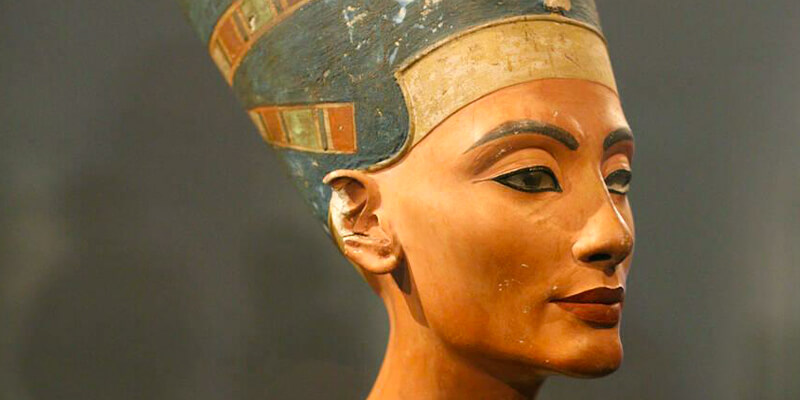
- We are always amazed by the mysterious stories and secrets of ancient Egypt. One of the most intriguing secrets of this exciting society is what happened to Queen Nefertiti, one of its most famous people. Nefertiti’s disappearance has been a mystery to historians and researchers for centuries. She was known for her stunning beauty and essential role during the rule of her husband, Pharaoh Akhenaten.
- According to historical records, Nefertiti and Akhenaten were both in charge during their rebellious rule in the 14th century BC. But around the 12th year of their power, she quickly disappeared from official records and histories, leaving an exciting gap in the history of ancient Egypt. Even though she seems to have disappeared, there isn’t much proof to suggest that she just stopped being. So, what did happen to this famous queen?
- One idea says Nefertiti might have died too soon from an illness or an accident. But this theory needs more proof to back up its claims. Another exciting idea is that Nefertiti might have taken on a new name. Some people think she might have changed her name and ruled Egypt under a different title to escape trouble when Egypt was going through a rough patch.
- One of the most exciting ideas is that Nefertiti was a female king named Smenkhkare. This idea says that after Akhenaten died, Nefertiti took over as Pharaoh and pretended to be a man so she could continue to rule. People who believe this idea point to art that shows Smenkhkare with clearly female traits, which they say shows a link to Nefertiti. But there is little information to back up this claim.
- Even though archaeologists and explorers have been looking for Nefertiti’s lost remains for hundreds of years, her final resting place has yet to be found. The beautiful bust of Nefertiti, found by the German researcher Ludwig Borchardt in 1912, is probably the most famous picture of the queen. But this beautiful item doesn’t tell us anything about what happened to her or who she is.
- Nefertiti’s absence is still a riddle that experts and casual fans are interested in. As we learn more about ancient Egypt, we hope that new finds will help us figure out what happened to this well-known person. Until then, the story of how Queen Nefertiti disappeared is a fascinating mystery that makes us want to discover the truth about her lost queen status or possible hidden identity.
The Sphinx: Guardian of Secrets or Astronomical Marvel?
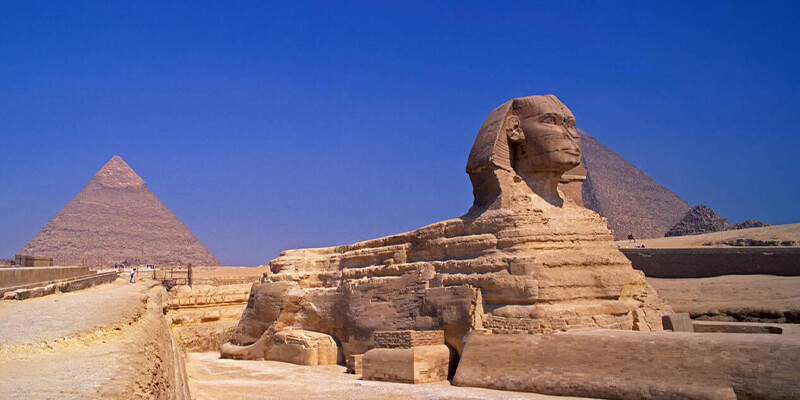
- When you look at the towering Sphinx, its mysterious smile draws you in and makes you wonder what it was made for. This old building has attracted scholars, scientists, and curious people for centuries. Mainstream theories say that it was built as a guardian or a sign of royalty. Other ideas, on the other hand, say that the Sphinx has something to do with the stars, which could make it an astrological marvel.
- Another idea is that the Sphinx was built to match natural events, like the sun’s cycle. Researchers say its position aligns with when the sun rises and goes down on the equinoxes and solstices. During the spring equinox, the head of the Sphinx lines up with the star Leo. This is a significant event. This link between the stars’ movement and the Sphinx’s location shows that ancient people were interested in science and that it was built with a plan.
- People thought the Sphinx was more than just a beautiful piece of architecture; they believed it held confidential information and secrets. Ancient Egyptians were known for how much they knew about the stars and how they related to the gods. Some think the Sphinx was a guardian of ancient knowledge, hiding important information in its stone structure. Some say that the Sphinx’s hidden secrets could help us solve puzzles that have baffled us for thousands of years.
- This different point of view questions what most people think the Sphinx is for and makes us think about myths and how the universe works. Were the ancient Egyptians trying to show how much they knew about the stars through this impressive building? Could the Sphinx be a reminder of when people knew much about astronomy and how the earth and the heavens worked together?
- While the mysteries surrounding the Sphinx persist, one thing remains certain: it continues to captivate our imagination and ignite our curiosity. Whether the Sphinx is a defender of hidden secrets, a miracle of astronomy, or both, its constant presence in the sands of Egypt invites us to explore and discover. Let’s figure out what its mysterious smile means and find the secrets hidden in its ageless gaze so we can get closer to figuring out what this ancient wonder was made for.
Lost Tombs and Hidden Treasures: Ancient Egyptian Burials
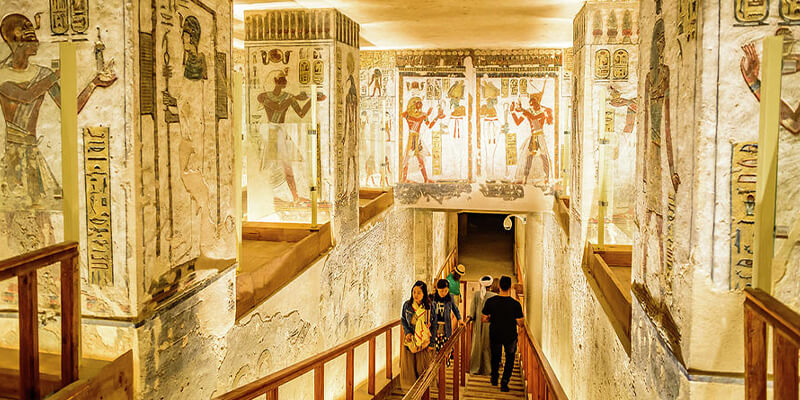
- Enjoy the stories of lost tombs and the hard-to-find quest to find secret wealth in ancient Egypt’s huge cemeteries. The secrets of how this ancient society buried its dead have captivated travelers, historians, and history buffs for hundreds of years. Egypt’s pharaohs and nobles hid their secrets in the dunes and under the hot sun, where they were still waiting to be found.
- One of the most famous lost tombs that have kept scholars guessing is that of Tutankhamun, the boy king. In the Valley of the Kings, in 1922, British researcher Howard Carter found the unopened tomb of this young king. Inside its walls, he found jewels that were nothing short of amazing. The grave was filled with gold objects, detailed jewelry, and beautifully painted sarcophagi. These things showed how rich and grand ancient Egyptian burials were. But could there be more tombs hiding in the desert that have yet to be found?
- Since Carter’s famous find, people still want to find secret riches. Archaeologists dig deep into ancient tombs to find lost pharaohs and their untold wealth. Even in the Valley of the Kings, which has more than sixty known tombs, there are still riddles to be solved. With each new dig, we learn a little more about how the ancient Egyptians thought about the future and what lengths they went to to ensure their endless glory and protection.
- These lost tombs hold valuable treasures and tell us a lot about how the ancient Egyptians lived, what they believed, and how they did things. The stories of the kings and their people can be seen in the tombs’ paintings, hieroglyphics, and personal items. Each new something found about this fascinating society fills another piece of the puzzle. This includes everything from detailed scenes of farming and art to amulets that protect the afterlife.
- Ancient Egypt will always be attractive to explorers and students because of its lost tombs and secret wealth. This trip goes beyond time and connects us with a society hidden in tales and myths. As we learn more about the secrets of ancient Egypt, we will find more lost treasures and tombs, which will shed light on an exciting time in human history. So, let’s go out into the vast necropolises of Egypt, full of wonder and armed with tools for exploring, to find out what secrets they hold.
Cleopatra’s Lost Library: Enigmatic Texts and Untold Knowledge
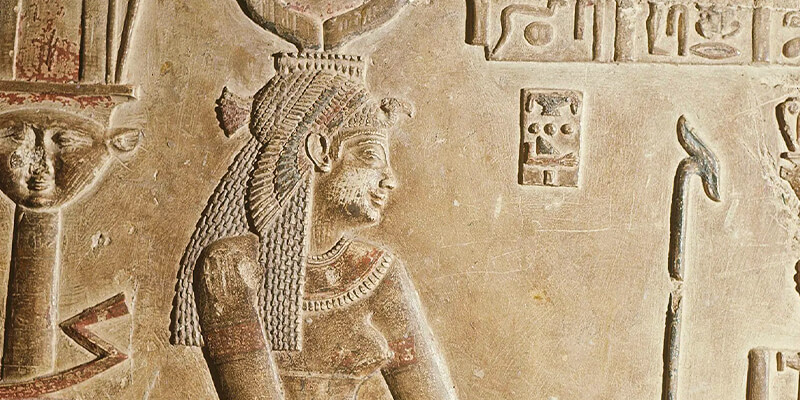
- One of the greatest mysteries of Ancient Egypt revolves around Cleopatra’s Lost Library, an enigma that has captivated historians and archaeologists for centuries. Ancient texts and history reports said that Cleopatra, the last queen of Egypt, owned this personal collection of knowledge. Scholars and treasure hunters are interested in the presence of this lost library because it is said to hold a lot of hidden knowledge and exciting information.
- Histories say that Cleopatra was a brilliant and well-educated queen who loved to learn and grow her knowledge. People generally agree that she liked books, logic, and science, which makes it more likely that Cleopatra had her secret library. It is thought that this library, part of her palace complex in Alexandria, held many old scrolls and books on topics like medicine, science, math, philosophy, and more.
- The idea that Cleopatra’s Lost Library might exist brings up a lot of questions and gets people thinking about the mysteries of the past. Could this secret gem be the key to finding knowledge and wisdom from long ago? A library like this could be handy to scholars because it could show how far people had come and what they were thinking about at the time.
- But because Cleopatra’s Lost Library is hard to find, many people still hope to see it. Even though many archeological digs and careful efforts have been made to find this old wealth chest, no solid proof of its presence has been found. Some people think the library was destroyed by the wars and changes after Cleopatra’s rule, while others believe it could still be buried under the sands of time, ready to be found.
- History scholars and researchers are still drawn to the idea of Cleopatra’s Lost Library, which keeps them looking for it. The amount of information inside its walls could change how we think about Ancient Egypt and how intelligent its people were. As we try to figure out what this old society was all about, the search for Cleopatra’s Lost Library is a warning that there are still a lot of secrets hidden under the sands of time, ready to be found by people who are curious and determined.
Ancient Egyptian Cosmology: The Fascinating Worldview of a Bygone Era
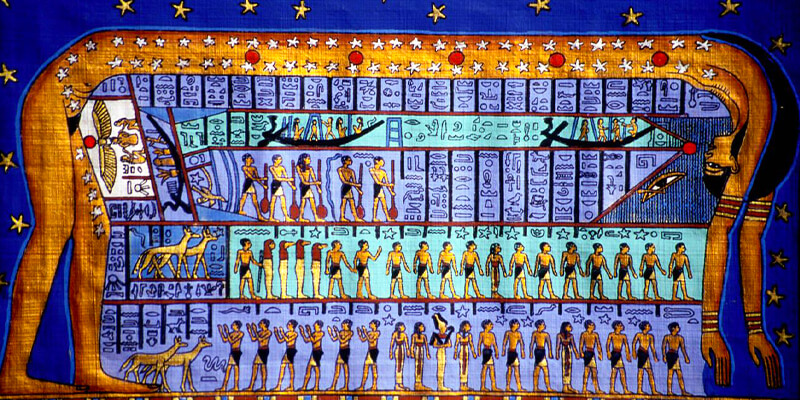
- The Mysteries of Ancient Egypt have captivated the imagination of people for centuries. Their ideas about the universe are one of the most exciting things about their culture. Ancient Egyptians had a unique and interesting view of the world that affected their thoughts about the universe, the future, and their complex myths.
- Ancient Egyptian mythology was based on the idea that a supernatural order ruled everything. They thought of the universe as a prominent, interconnected structure where everything was tied together in a complicated way. The sky, the ground, and the underworld were all parts of their idea of the universe. These three realms were all linked and affected how the others worked.
- The ancient Egyptians thought that the gods and goddesses lived in the sky. They believed that the gods lived in the heavens and were in charge of things like the sun, moon, stars, and the yearly flooding of the Nile. In their worldview, the sun was essential because it represented life, light, and rebirth. They believed that Ra, the sun god, made and kept all life going.
- On the other hand, people thought the land was theirs and rooted in Ma’at, the heavenly idea of balance and order. The ancient Egyptians believed that keeping Ma’at in balance was necessary for the health of their society, so they tried to live by its rules.
- The ancient Egyptians believed that the dead lived in a place called Duat, the land of the dead. They thought that after death, the soul went on a dangerous journey through the Duat, where it faced many trials and problems. They felt that if they mummified the body and did complicated funeral rites, the soul would have a better chance of making it through the dangerous path of the Duat and living forever in the afterlife.
- Ancient Egyptian theology was closely linked to their rich and complicated myths. Their universe had a lot of gods and goddesses, and each had a different job and set of traits. These gods stood for things in nature, like the forces of nature, fertility, and the processes of life and death.
- Ancient Egyptian mythology shows us how people thought and what they believed in the past. It shows how much the ancient Egyptians respected nature, how much they wanted to learn and understand, and how much they wanted to live forever. When we know what they thought about the universe and how it worked, we can better understand how complex and advanced this old society was and how it still affects our world today.
Rituals of the Afterlife: A Journey Through the Egyptian Book of the Dead
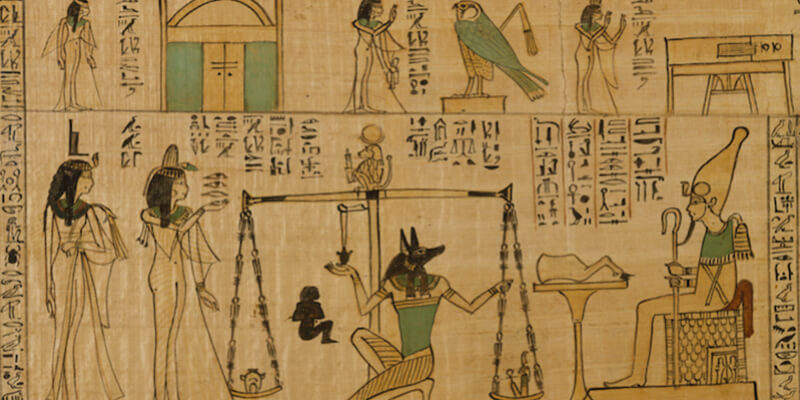
- The mysteries of Ancient Egypt never cease to intrigue and captivate the modern world. One of the most exciting things about this old culture is their belief in the future and the practices that followed it. When we look into the details of these rites, we get to the heart of the mysterious Egyptian Book of the Dead, an engaging funeral text that tells us about their complex beliefs about death and the journey to the future.
- The Book of the Dead is an ancient Egyptian book from the New Kingdom that helps the dead find their way through the dangerous trip to the future. It is a list of magic, prayers, and directions that the dead would have to say and follow to get past different problems they ran into on their way. The book is like a ticket, giving the souls of the dead the information and security they need to get through the dangerous places of the Netherworld.
- One of the most exciting things about the Book of the Dead is how it shows how the Egyptians thought the soul had two parts. According to their views, a person’s soul would be split into many parts after death, and each piece would have its reason and fate. The Ba, the Ka, and the Akh were the most important of these parts. The Ba stood for the personality and traits of the person who had died, and the Ka stood for the vital life force that kept the person alive. The final goal was for the dead person to turn into Akh, a heavenly, everlasting being that could move quickly between the earthly and divine worlds.
- The traditions written in the Book of the Dead will start when a person dies. They included many different things, like putting the body through a complicated process of mummification, reciting spells, and putting a lot of protective amulets in the tomb. The rites were made to guide and protect the soul, ensuring it would live and return to life.
- The Egyptians prepared for the trip after death by paying close attention to every detail. The Book of the Dead was like a map, giving the dead the information and directions they needed to find their way through the underground and live a happy life in the future. It summarizes the complicated practices, magic, and beliefs that fascinate and baffle experts and fans.
- In trying to figure out what happened in Ancient Egypt, the practices surrounding death and the future written down in the Book of the Dead show how deeply people believed in their gods and how spiritual they were. Their unshakable belief that life goes on after death, as demonstrated by their complicated practices and magic, reminds us of how people have always tried to live forever and of the secrets that lie beyond our physical realm.
In conclusion, Ancient Egypt’s enduring allure and the mysteries that captivate us never cease to amaze us. People have been interested in this old society for a long time because of how grand the pyramids are and how mysterious the hieroglyphics are. We are most interested in the parts of their culture that we can’t understand, like their advanced scientific knowledge, fantastic architecture, and complex religious beliefs. These tales make us want to go back in time and discover what stories and secrets are hidden in the ruins of Ancient Egypt.
To get history and historical research going again, it’s essential to encourage travel and study to learn more about Ancient Egypt. By taking on the tasks of things like understanding old hieroglyphics or figuring out what huge figures are really for; we make room for new finds. The more we learn about this ancient society, the more we realize how complicated and unique it was. By supporting a spirit of discovery, we can raise a new generation of Egyptologists who will continue to solve the many mysteries still hidden in the sands of Egypt.
Learning about history and being interested in it is essential for understanding Ancient Egypt and enjoying the variety and depth of human society. Ancient countries like Egypt are fascinating because they make us want to learn more and give us ideas. It tells us that there are still a lot of unexplored parts of the past that can teach us a lot about the successes, mistakes, and creativity of those who came before us. By exploring the secrets of Ancient Egypt, we set out on a trip that ties us to our shared human history and feeds our desire for solutions that span time. So, let’s never stop digging up the secrets of the past and, in doing so, keep learning more about our world.
Are you considering a trip to Egypt? Stop looking! Egypt has a lot of fun things to do for tourists, like fantastic vacation packages, unforgettable day tours, and luxury Nile trips. Egypt has something for everyone because of its long history and beautiful scenery. Explore the majestic pyramids of Giza, get lost in the ancient wonders of Luxor and Aswan, or take a magical trip along the famous Nile River. Egypt Vacation packages give you the best of this great country by giving you a good mix of culture, excitement, and rest. Egypt Day tours offer people who want to learn more about the country’s history and culture the chance to do so with the help of experts who bring the stories of old Egypt to life. And if you want to treat yourself, go on an Egypt Nile River Cruise, where you can take in the beauty of the river while having top-of-the-line amenities and service at the highest level. Egypt has something for everyone, whether you like history, want to try new things, or want to relax in a beautiful place. Start planning your dream trip right now, and let Egypt’s amazing sights take your breath away.

